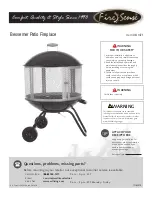
7
8. Ensure the power supply voltage and phase at the job site
matches the power requirements on the HPWH rating label
before installation begins. Energizing the HPWH with the
wrong voltage or phase will cause permanent damage to the
unit.
PRINCIPLE OF OPERATION
The appliances covered by this Instruction Manual are
commercial air-to-water heat pump water heaters (HPWH).
Operation of the HPWH is similar to that of a package air
conditioning system though the HPWH is designed for indoor
installation only. The primary difference in operation is that
the HPWH unit utilizes the heat removed from the conditioned
space to heat water where package air conditioning systems
discard this heat outdoors. Recovering and using this waste heat
increases the overall energy efficiency of the building.
THE REFRIGERATION CYCLE
Refer to Figure 1 on page 8 for the location of components
mentioned in this section.
Refrigerant is circulated through the refrigeration circuit by a
Compressor
(1). The refrigerant is a high temperature high
pressure gas when it leaves the compressor. Refrigerant
flows from the compressor through the
Hot Gas Line
(2) to the
Condenser
(3).
The condenser is a refrigerant-to-water heat exchanger with two
circuits, refrigerant flows through one circuit and water through
the other. The high temperature refrigerant gas transfers its heat
to the water flowing through the condenser. As the refrigerant
gas cools inside the condenser it changes state (condenses)
from a gas to a liquid. A
Water Pump
(B) circulates water through
the condenser.
Refrigerant leaving the condenser is a medium temperature
high pressure liquid. It flows through the
Liquid Line
(4) to the
Thermostatic Expansion Valve
(5). The thermostatic expansion
valve (TXV) regulates the flow of refrigerant into the
Evaporator
(6). The evaporator is a tube-and-fin constructed coil. It is an air-
to-refrigerant heat exchanger with refrigerant flowing through the
tubes and air flowing across the fins.
The
Blower
moves ambient air from the installed space or air
ducted to the HPWH from another location across the fins of
evaporator coil. The refrigerant absorbs heat from the air in the
evaporator. The refrigerant changes state (boils/evaporates)
from a liquid state back into a gas (vapor) in the evaporator.
The refrigerant flows out of the evaporator through the
Suction
Line
(7) and into the
Accumulator
(8). The accumulator traps any
liquid refrigerant the evaporator is unable to vaporize during low
temperature operating conditions. The accumulator prevents
liquid refrigerant from entering the compressor where it could
damage internal components.
Low temperature low pressure refrigerant gas (vapor) is drawn
out of the accumulator by the compressor. The compressor
increases the pressure and temperature of the refrigerant gas
circulating it to the condenser again where the refrigeration cycle
starts over or continues.
AIR TEMPERATURE RANGE
The entering air temperature operating range for the HPWH is
50°F to 95°F (10°C to 35°C).
When the HPWH is operating properly the air temperature drop
through the evaporator (heat exchanger) will be approximately
12°F to 20°F (7°C to 11°C).
WATER TEMPERATURE RANGE
The inlet (entering) water temperature operating range for the
HPWH is 50°F to 140°F (10°C to 60°C).
When the HPWH is operating properly the water temperature rise
through the condenser (heat exchanger) will be approximately
8°F to 12°F (4°C to 7°C).
REFRIGERANT CHARGE
The HPWH is factory-charged with R-134a refrigerant. The
refrigerant charge is weighed in at the factory. See Table 9
on page 28. It should not be necessary to add or remove
refrigerant during installation or start up.
EQUIPMENT DISPOSAL
This heat pump water heater contains R-134a refrigerant and is
regulated as a stationary refrigeration appliance under Section
608 of the Clean Air Act. Disposal of this unit must be performed
in accordance with the provisions in Section 608 of the Clean Air
Act and any state or local regulations that may also apply. See
Summary of Contents for AWH-35
Page 2: ......
Page 32: ...UNIT WIRING DIAGRAMS FUSE SIZES 208 230 VAC SINGLE PHASE 60 HZ 32...
Page 33: ...UNIT WIRING DIAGRAMS FUSE SIZES 208 230 VAC THREE PHASE 60 HZ AWH 35 AWH 55 and AWH 75 only 33...
Page 34: ...UNIT WIRING DIAGRAMS FUSE SIZES 208 230 VAC THREE PHASE 60 HZ only 34...
Page 35: ...UNIT WIRING DIAGRAMS FUSE SIZES 460 VAC THREE PHASE 60 HZ 35...
Page 36: ...UNIT WIRING DIAGRAMS FUSE SIZES 460 VAC THREE PHASE 60 HZ only 36...








































